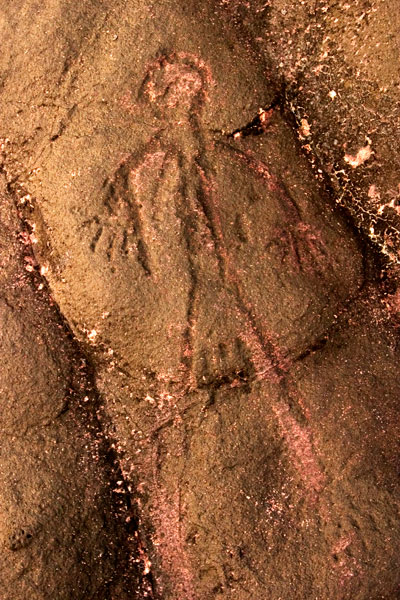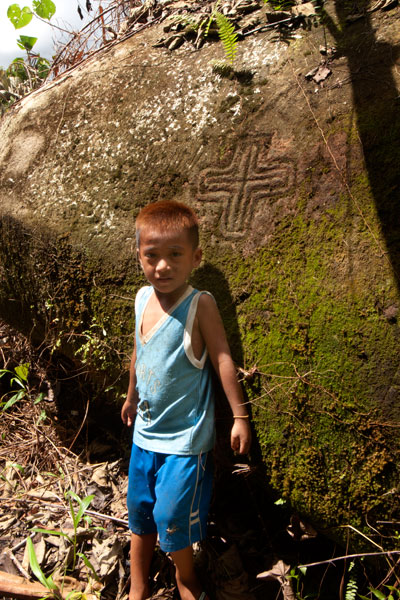Just south of the newly renovated Sapwalap Elementary School lies one of Micronesia’s most unusual sites. More than 700 prehistoric motifs are inscribed on rocks in the area, the largest collection adorning a 60 by 25 meter naturally terraced basalt outcropping called Pohnpaip (“on the boulder”). Though the pictures are fading in the face of Pohnpei’s relentless rains, it’s still possible to discern human figures, feet, hands, fish hooks, a boat, the sun and moon, and many shapes that may be canoe paddles or loom pegs (often mistaken for daggers).
Different stories are told about the origin of this rock. In one, the outcropping was created when two mischievous brothers named Mwohnmur and Sarapwau — the same boys who created Takaiuh in the Kepine area and the Sahwar Gorge in Salapwuk — stole a blanket from Kitti decorated with strange symbols (some informants attribute this action to Olsihpa and Olsohpa instead of Mwohnmur and Sarapwau). The blanket was transformed into the rock with the symbols still intact. In another tale, Pohnpaip was the house of two men, Mahntik and Mahnlap, who passed into the rock through a magical door and traveled to a far land. Knocking with small stones at the location where the door to the house is purported to be produces a hollow sound as if there were, indeed, a cavity beneath the rock’s surface.
More petroglyphs are found on a collection of smaller boulders located in the grassy plain to the northeast. The large rock closest to Pohnpaip is called Takain Pahsu (“vagina rock”) and is said to be the genitalia of a mythical woman who broke into pieces. The woman’s buttocks are found on the other side of the road along with several other boulders with petroglyphic images. One is covered with enveloped equilateral crosses similar to those found in Vanuatu, New Caledonia, and the Solomon Islands, possibly indicating a link between the site and the Lapita culture active in the region about 2,000 years ago. To date, no one is sure who created the petroglyphs or when they were created. Rock art of this sort is uncommon in the Micronesian islands.
The road leading to the site was in very bad condition as of 2014. It’s best to park near the Circle Island Road and walk up. The Herson family, which owns the land around Pohnpaip, charges an access fee of $3.00 per person. You don’t need a guide, but more than likely someone at the house will show you up to the rock and other sites at no extra charge.
- This excursion takes about 2 hours round-trip if you take your time and really examine all the images.



